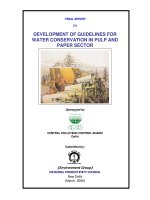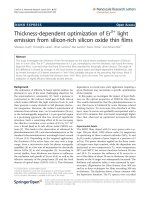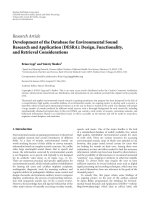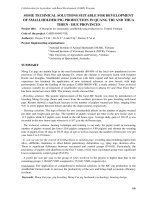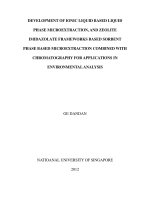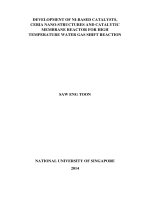Development of lead free electroless nickel plating systems and metal thin films on silicone and nafion membranes
Bạn đang xem bản rút gọn của tài liệu. Xem và tải ngay bản đầy đủ của tài liệu tại đây (5.48 MB, 241 trang )
DEVELOPMENT OF LEAD-FREE ELECTROLESS
NICKEL PLATING SYSTEMS AND METAL THIN
FILMS ON SILICONE AND NAFION
MEMBRANES
WANG KE
NATIONAL UNIVERSITY OF SINGAPORE
2008
DEVELOPMENT OF LEAD-FREE ELECTROLESS
NICKEL PLATING SYSTEMS AND METAL THIN
FILMS ON SILICONE AND NAFION
MEMBRANES
WANG KE
(M.Sc., CUGB; M.Eng., CUGW)
A THESIS SUBMITTED
FOR THE DEGREE OF DOCTOR OF PHILOSOPHY
DEPARTMENT OF CHEMICAL AND BIOMOLECULAR ENGINEERING
NATIONAL UNIVERSITY OF SINGAPORE
2008
ACKNOWLEDGEMENTS
I would like to express my sincere gratitude to my supervisor, A/Prof. Hong Liang,
and my co-supervisor, Dr. Liu Zhao-Lin, for their invaluable guidance and
suggestions, continual encouragement, great patience and support throughout the
course of my study.
I would like to specially thank all the technical and clerical staff in the Department
of Chemical & Biomolecular Engineering for their assistance in the set-up of
experimental systems and in the use of materials characterization equipments.
Thanks are also extended to Mr. Yin Xiong, Ms. Zhang Xinhui and Ms. Tay Siok
Wei for their supportive comments and cheerful assistance.
I am extremely grateful to my beloved family members for their love and support
throughout the course of this program.
Finally, I would like to thank to National University of Singapore for granting me a
research scholarship throughout this study period.
i
TABLE OF CONTENTS
Acknowledgements
i
Table of contents
ii
Summary
x
Nomenclature
xiv
List of figures
xv
List of tables
xx
Chapter 1 Introduction 1
1.1 Background 1
1.2 Objectives of this thesis work 4
1.3 Thesis organization 5
Chapter 2 Literature Review 9
2.1 Electrochemical metal deposition methods 9
2.1.1 Electrolytic metal deposition/plating 9
2.1.2 Electroless metal deposition/plating 11
2.1.3 Advantages of electroless deposition 14
2.2 History overview of ENP 14
2.3 Basic composition of ENP 15
2.3.1 Nickel source 16
ii
2.3.2 Reducing agents 17
2.3.3 Complexing agents 20
2.3.4 Surfactants 21
2.4 Reaction mechanisms of ENP in acidic
hypophosphite bath
22
2.4.1 Atomic hydrogen mechanism 23
2.4.2 Hydride transfer mechanism 24
2.4.3 Electrochemcial mechanism 26
2.4.4 Metal Hydroxide Mechanism 27
2.4.5 Mixed potential theory 28
2.5 Process of ENP 29
2.5.1 Pretreatment of substrate 29
2.5.1.1 Intrinsically active materials 30
2.5.1.2 Extrinsically catalytic materials 30
2.5.2 Effects of variables on the ENP process 31
2.5.2.1 Effect of temperature 31
2.5.2.2 Influence of pH 32
2.5.2.3 Influence of nickel and hypophosphite ion
concentration
32
2.5.2.4 Influence of phosphite anion 33
2.5.2.5 Influence of complexing agents 34
2.5.2.6 Influence of agitation 34
2.5.2.7 Influence of bath loading 34
2.6 Structure and properties of electroless nickel (EN)
deposits
35
2.6.1 Structure of EN deposits 35
iii
2.6.2 Properties of EN deposits 36
2.6.2.1 Mechanical properties of EN deposit 36
2.6.2.2 Internal stresses in EN deposit 36
2.6.2.3 Electric and magnetic properties of EN deposit 37
2.6.2.4 Corrosion resistance of EN deposits 37
2.6.2.5 Wear properties of EN deposits 39
2.7 Applications of ENP 40
2.7.1 Engineering applications 40
2.7.2 Magnetic applications 40
2.8 Stabilizers for ENP 41
2.8.1 Inorganic substitute stabilizers 44
2.8.2 Organic substitute stabilizers 45
2.9 Metallization of hydrophobic silicone elastomer 48
2.9.1 Metallization of polymers by different methods 48
2.9.2 Metallization of Poly(dimethylsiloxane) (PDMS) 50
2.10 Development of Pt-based electrocatalysts for
proton exchange membrane fuel cells (PEMFCs)
52
2.11 Problem definition 54
Chapter 3 Roles of Sulfur-Containing Amino Acids
in Electroless Nickel Plating Bath
56
3.1 Introduction 57
3.2 Experimental 59
3.2.1 Materials 59
3.2.2 Plating rate vs stabilizer concentration 59
iv
3.2.3 Electrochemical analysis of the oxidation rate of
hypophosphite
61
3.2.4 Assessment of ENP bath stability 62
3.2.5 Evaluation of corrosion resistance 62
3.2.6 In situ adsorption of the two amino acids on fresh
nickel powders
63
3.2.7 Other instrumental analyses 63
3.3 Results and Discussion 64
3.3.1 An investigation of the dual effects of the two S-
containing amino-acids on ENP rate
64
3.3.2 Nature of S-containing group and the composition
of Ni/P deposition layer
74
3.4 Conclusions 80
Chapter 4 The Role of Bi3
+
-Complex Ions as the Stabilizer
in the Electroless Nickel Plating Process
82
4.1 Introduction 83
4.2 Experimental 85
4.2.1 Materials 85
4.2.2 Determination of characteristics of ENP process
and deposit
85
4.2.3 Other instrumental analyses 86
4.2.4 Palladium titration 86
4.3 Results & Discussion 87
4.3.1 Influence of Bi3+-complex ion on anodic reaction
of hypophosphite
87
4.3.2 The critical role of metal colloidal particles
generated in ENP solution
97
v
4.3.3 The effect of stabilizer concentration on the
performance of ENP bath
100
4.4 Conclusions 105
Chapter 5 Exploring the Phosphine Ligands as Stabilizer
for the ENP System
107
5.1 Introduction 108
5.2 Experimental 110
5.2.1 Materials 110
5.2.2 Determination of characteristics of ENP process
and deposit
110
5.2.3 Heat treatment of as-deposited Ni-P layer 111
5.2.4 Evaluation of corrosion resistance 111
5.2.5 In situ adsorption of the three phosphines on fresh
nickel powders
112
5.2.6 Other instrumental analyses 112
5.2.7 Palladium titration 113
5.3 Results & Discussion 113
5.3.1 The state of phophine compounds in ENP aqueous
solution
113
5.3.2 A study on how the phosphines influence the ENP
deposition rate
117
5.3.3 How will phosphines improve corrosion resistance
of Ni-P deposit?
126
5.3.4 How will the use of phosphine stabilizer affect the
heat treatment effect?
129
5.3.5 The performance of phosphines in a continuous
ENP process
136
5.4 Conclusions 138
vi
Chapter 6 Developing a Well-Adhered Ni/P Alloy Film on
the Surface of Silicone Elastomer for Shielding
Electromagnetic Interference (EMI)
140
6.1 Introduction 141
6.2 Experimental 143
6.2.1 Materials and sample preparation 143
6.2.2 Deposition of catalyst 144
6.2.3 Electroless nickel plating 144
6.2.4 Contact angle measurement 145
6.2.5 Field emission scanning electron microscopy
(FESEM)
145
6.2.6 Atomic force microscopy (AFM) 145
6.2.7 Adhesion measurement 146
6.2.8 Measurement of magnetic property 146
6.3 Results and Discussion 147
6.3.1 Effect of surfactant on the crosslinking of PDMS 147
6.3.2 Wettability of modified PDMS 148
6.3.3 Attaching a TiO2 layer to the PDMS surface via
gluing approach
149
6.3.4 Appearance of modified PDMS 151
6.3.5 Deposition of Pd on modified PDMS 151
6.3.6 Surface/cross-sectional morphology and
composition of Ni deposit on modified PDMS
154
6.3.7 Adhesion between the deposited Ni-P film and the
modified PDMS substrate
158
6.3.8 Surface resistivity of EN plated PDMS 160
6.3.9 Hysteresis loop of EN plated PDMS 162
vii
6.3.10 Electromagnetic shielding by EN plated PDMS 163
6.4 Conclusions 165
Chapter 7 Electroless Deposition of Anode Catalyst on
Nafion
®
Membrane – A New Approach for the
Fabrication of MEA
166
7.1 Introduction 167
7.2 Experimental 169
7.2.1 Materials 169
7.2.2 Electroless Pt and Au plating 170
7.2.3 Determination of metal loading 171
7.2.4 Instrumental analyses 171
7.2.5 Ion exchange treatment 172
7.2.6 Cell performance 172
7.3 Results and Discussion 173
7.3.1 Deposition of Pd on Nafion
®
membrane 173
7.3.2 Electrolessly plated Pt on Nafion
®
membrane 174
7.3.3 Electrolessly plated Pt/Au on Nafion
®
membrane 177
7.3.4 Catalytic performance of the fabricated anodes in
PEMFC
183
7.4 Conclusion 185
Chapter 8 Conclusions and Recommendations 187
8.1 Conclusions 187
8.2 Suggestions for the future work 189
viii
8.2.1 Application of environmental-friendly stabilizers in
alkaline ENP bath
189
8.2.2 Theoretical models for describing working
mechanisms of organic stabilizers
190
8.2.3 Patterned ENP on plastics 192
References
194
ix
SUMMARY
Electroless metal deposition/plating, as a versatile surface finishing technology, has
been successfully applied in many industries to date. Among the established
electroless plating systems, the electroless nickel plating (ENP) system is of the
most importance due to its significant industrial value. ENP generally produces an
integrity Ni-P alloy film on the target substrate with very strong adhesion strength
and unique physical and chemical properties, such as, hardness, corrosion resistance,
wear resistance and so on.
Being an autocatalytic reaction at the plating frontier, the ENP process is vulnerable
to decompose at any time due to the presence of insoluble colloidal particles in the
plating solution as the plating proceeds. In most of commercial ENP applications,
lead is introduced in the ppm level as the stabilizer to ensure a stable plating process
that consists of several metal-turnover (MTO) rounds. But the co-deposition of Pb(0)
atom in the EN deposition layer and the presence of Pb
2+
ion in the spent solution
cause harmful effects to the human beings and high cost for the waste-solution
treatment. Hence, it has been an urgent issue to explore a less toxic or environmental
friendly stabilizer in place of Pb
2+
ion in ENP solutions.
Another challenge to the development electroless metal plating is how to apply this
technique in the arena of Hi-tech, i.e., biomedical and new energy industries, in
which the metallization of polymer materials is an essential step.
x
Poly(dimethylsiloxane) (PDMS) is an important polymeric material that has broad
applications because of its excellent thermal and chemical stability. The surface
metallized PDMS is expected to find applications in the medical/health industry.
However, electroless metallization on PDMS is seldom reported due to its high
hydrophobicity.
Proton exchange membrane fuel cell (PEMFC) is regarded as an alternative power
generator to the combustion engine for PEMFC uses hydrogen fuel and has a higher
efficiency, higher power density and zero pollutant emissions. The performance of
PEMFCs greatly depends on the membrane electrode assembly (MEA), in which an
electrolyte membrane is sandwiched between two electrodes. Among different
electrolyte membranes, Nafion
®
is the most commonly used because of its good
mechanical and chemical stability and high proton conductivity. The enhancement
of Pt utility and improvement of the endurance of Pt catalyst to carbon monoxide
and other oxidative intermediates are the key issues which will affect the market
acceptance of PEMFC. Electroless Pt and Au plating approaches were attempted in
this thesis work with the aim to deposit Pt or Pt-Au bimetallic catalyst directly on
the surface of Nafion
®
membrane. Here the built Pt-Au bimetallic nanoparticle is
anticipated to improve the resistance of the Pt catalyst to poisoning adsorbates.
The interest of this PhD research is to investigate solutions to the above problems,
namely exploring effective substitutes for lead salt stabilizer in ENP system and
advancing electroless plating technology for the fabrication of special devices. In the
first part of this thesis, three kinds of environment friendly and effective bath
stabilizers are presented. They are sulfur-containing amino acids (cysteine and
xi
methionine), Bi
3+
-complex ions and phosphines. Among them, cysteine, methionine
and Bi
3+
-complex ions stabilize the ENP bath by controlling the oxidation rate of
hypophosphite ions at the plating surface. Each of them exhibited a wide effective
stabilizing range from 10
-9
to 10
-5
mol/L before the critical concentration, above
which the EN plating becomes idle. Below the critical concentration, the
concentrations of stabilizers did not show significantly effects on the characteristics
of ENP process and EN deposit. Although the sulfur-containing amino acid type and
Bi
3+
-complex ion type are anodic type stabilizers, they are associated with different
stabilization chemical mechanisms.
Unlike sulfur-containing amino acids and Bi
3+
-complex ions, phosphines are a type
of cathodic stabilizer that prevents the ENP process from decomposition through
suppressing the rapid reduction of Ni
2+
ions at highly reactive Ni surface sites. And
consequently, there is no a critical concentration for them. It is unique for
phosphines that the phosphorus-content in the Ni-P deposition layer gradually
increases by increasing the concentration of phosphines in the solution, which
results in the improvement of anti-corrosion property of as-deposited Ni-P plating
layer. In addition, thermal annealing of the Ni-P layer could largely promotes its
corrosion resistance by almost 20 times due to the formation of diffusion layer
between the brass substrate and crystalline layer.
In the second part, methods for metallization of PDMS and Nafion
®
membrane are
reported. Firstly, a method to electroless plate a well-adhered Ni/P alloy thin film on
the surface of modified PDMS was successfully developed. At the first, PDMS was
modified by including an appropriate surfactant in the PDMS matrix and partially
xii
embedding TiO
2
nonoparticles on its surface to make a hydrophilic and rough
surface; and then, ENP was carried out on the surface of modified PDMS substrate
after activated in a Pd/SnCl
2
suspension. The deposited Ni-P alloy film is rough and
irregular in structure and shows high electrical conductivity and an electromagnetic
interference (EMI) shielding property.
Secondly, methods to deposit PEMFC anode catalyst directly to Nafion
®
membrane
by means of electroless plating, in which Pt or Pt-Au bimetallic thin layer consisted
of highly dispersed particles with size smaller than 100 nm, were successfully
developed. The size of deposited metal particles and the surface morphology of
deposition layer were found to strongly depend upon the plating time. According to
the assessment in a single stack PEMFC, both of Pt and Pt-Au catalysts displayed
better electrode reactivity than the normally used carbon black supported PtRu
catalyst; whereas Pt/Nafion
®
anode showed better cell performance than Pt-Au/
Nafion
®
anode when the current density was above 1.4 A/cm
2
.
Keywords: electroless nickel plating (ENP), stabilizer, sulfur-containing amnio
acids, Bi
3+
-comples ions, phosphines, stabilization mechanism, surface metallization,
poly(dimethylsiloxane) (PDMS), electromagnetic interference (EMI); Nafion
®
membrane, polymer electrolyte membrane fuel cell (PEMFC), Pt-based catalyst
xiii
NOMENCLATURE
Symbol Description Unit
A
plating area in Eq. (3.1) cm
2
a
a constant in Eq. (4.1)
CPE constant phase element F
C
s
stabilizer concentration mol/L
C
S
c
critical stabilizer concentration in Eq. (4.1) mol/L
D length of the wires Eq. (6.2) cm
E
f
0
Fermi energy level in Eq. (4.1) eV
I
s
current Eq. (6.2) A
k
Boltzmann constant in Eq. (4.1) eV/K
L distance between two wires Eq. (6.2) cm
L
Pt
platinum loading in Eq. (7.1) mg/cm
2
p
dipole moment D
Rc/ corrosion resistance of the coating Ω
R
Ni
deposition rate of nickel in Eq. (4.1)
mg/cm
2
hr
R
Ni
0
nickel deposition rate without stabilizer in Eq. (4.1)
mg/cm
2
hr
R
P
deposition rate of phosphorus in Eq. (4.1)
mg/cm
2
hr
R
P
0
phosphorus deposition rate without stabilizer in Eq. (4.1)
mg/cm
2
hr
Rs resistance of the solution Ω
t plating time in Eq. (3.1) hr
T temperature K
U DC voltage in Eq. (6.2) V
V
d
decomposition volume ml
W
weight of plating layer in Eq. (3.1) g
Greek symbols
Symbol Description Unit
r
deposition rate in Eq. (3.1) μm/hr
ρ
s
surface resistivity Ω/sq
xiv
LIST OF FIGURES
Fig. 2.1 Schematic Representation of Electrolytic Metal Deposition 11
Fig. 3.1 Influence of concentration of sulfur-containing amino acids on
nickel deposition rate
65
Fig. 3.2 Current-potential curves of anodic oxidation of hypophosphite
on nickel at different cysteine concentrations (mol/L). 1) 10
-5
,
2) 10
-6
, 3) 10
-8
, 4) 0, 5) 2×10
-4
, 6) 10
-3
67
Fig. 3.3 Peak values of anodic current density vs. the corresponding
concentrations of sulfur-containing amino acids
67
Fig. 3.4 Schematic graph for interaction between sulfur-containing
amino acids and positively charged phosphorous center at
plating surface
69
Fig. 3.5 The UV-Vis spectra of nickel solution with methionine as
stabilizer 1) Methionine 0.05M, 2) Nickel sulfate 0.05M, 3)
Methionine 0.05M + Nickel sulfate 0.05M
69
Fig. 3.6 The structures of cysteine, methionine and methionine-Ni
2+
70
Fig. 3.7 XPS spectra of Ni 2P3/2 in four samples together with curve
fitting
72
Fig. 3.8 XPS spectra of S 2P3/2 in three samples together with curve
fitting
72
Fig. 3.9 FT-IR spectra of Ni-thiourea, Ni-cysteine and Ni-methionine 74
Fig. 3.10 Effect of MTO on nickel deposition rate with cysteine or
methionine as the stabilizer
76
Fig. 3.11 PDS curves of Ni-P coatings with methionine as stabilizer in
different rounds of MTO. M-1: 1st MTO, M-2: 2nd MTO, M-
3: 3rd MTO, M-4: 4th MTO
78
Fig. 3.12 Corrosion current density vs MTO for cysteine and methionine 78
Fig. 3.13 Surface morphology of the 3
r
d
and 4
t
h
MTO samples for a)
cysteine or b) methionine as the stabilizer
79
xv
Fig. 3.14 Surface morphology of the 1
s
t
and 2
n
d
MTO samples
for methionine as the stabilizer
79
Fig. 4.1 Structures of three EDTA-derivatives 88
Fig. 4.2 Influence of existence of Bi
3+
-complex ions on nickel
deposition rate
89
Fig. 4.3 Current-potential curve of anodic oxidation of hypophosphite
on Ni-P electrode in solution containing 0.24 mol/L
hypophosphite and 10
-6
mol/L Bi
3+
-EDTADSS
90
Fig. 4.4 Peak values of anodic current density vs. the corresponding
concentrations of Bi3+-complex ions
91
Fig. 4.5 The XPS spectra of (a) Bi 4f and (b) Ni 2p in four samples
after plated in ENP bath at different Bi3+-complex ion
concentrations for 30 mins
92
Fig. 4.6 EDX spectra of samples plated in ENP solution of [Bi
3+
]=10
-3
mol/L for different times: a) 1 min, b) 5 min, c) 10 min, d) 20
min (i.e., starting to count from the moment when the brass
substrate is touched by Ni wire)
94
Fig. 4.7 Influence of the Bi3+-complex ion concentration on the
deposition rate of a) nickel and b) phosphorus
97
Fig. 4.8 TEM photograph of colloidal particles collected from plating
bath with addition of 10
-5
mol/L Bi
3+
-EDTADSS after a 1 hr
plating process
98
Fig. 4.9 Dependence of decomposition volume (Vd) on concentration
of added stabilizers
99
Fig. 4.10 Effect of MTO on nickel deposition rate with using Bi3+-
complex ions as the stabilizer
101
Fig. 4.11 PDS curves of Ni-P coatings with Bi
3+
-EGTADSS complex as
stabilizer in different rounds of MTO
103
Fig. 4.12 Corrosion current density vs MTO for three bismuth
complexes
104
Fig. 4.13 Surface morphology of the 4 MTO samples by using Bi
3+
-
(EDTA-OH) complex as the stabilize
105
Fig. 5.1 Molecular structures of the three phosphines 114
xvi
Fig. 5.2 P31 NMR spectra of (a) 10 mg TPP in 5 ml DMSO-d
6
and
(b) 5×10
-5
mol/L TPP-LA complex in 5 ml DMSO-d
6
115
Fig. 5.3 Influence of concentration of phosphines on Ni-P deposition
rate
118
Fig. 5.4 The co-deposition of TPP or BDPPM insoluble particles on
the plating surface at high concentraton (10
-3
mol/L)
118
Fig. 5.5 Peak values of anodic current density vs. the corresponding
concentrations of phosphines. (For TPP and BDPPM the tested
concentration is up to 10
-5
mol/L, because neither of them can
be completely dissolved under the experiment conditions
above this concentration)
120
Fig. 5.6 Schematic presentation of adsorption of TPP and TPPTS on
the Ni plating surface
121
Fig. 5.7 XPS spectra of P 2P in four samples together with curve fitting 123
Fig. 5.8 Dependence of decomposition volume on added concentration
of stabilizers
124
Fig. 5.9 Nyquist plots obtained for as-plated EN deposits plated from
ENP bath using TPPTS as the stabilizer in 3.5% NaCl solution
128
Fig. 5.10 Equivalent circuit for EIS measurements on corrosion
resistance of as-deposited Ni-P deposits plated from ENP bath
using TPPTS as the stabilizer
129
Fig. 5.11 X-ray diffraction pattern of ENP deposition player before and
after heat treatment
131
Fig. 5.12 Surface morphology of ENP deposit layer generated from the
bath containing TPPTS of 10
-5
M before and after annealing
treatment
132
Fig. 5.13 Nyquist plots obtained for heat-treated EN deposits in 3.5%
NaCl solution
132
Fig. 5.14 Equivalent circuit for EIS measurements on corrosion
resistance of heat-treated Ni-P deposits
133
Fig. 5.15 Element Analysis on the cross section for EN deposits before
and after heat treatment
135
Fig. 5.16 Effect of MTO on the deposition rate with using phosphines
as the stabilizer
137
xvii
Fig. 5.17 Surface morphologies of the EN deposits from each MTO
round with TPP as the stailizer
138
Fig. 6.1 Contact angles of water on PDMS before and after
incorporating a surfactant
149
Fig. 6.2 XPS analysis of the three PDMS surfaces where TiO
2
nanoparticles were embedded.
150
Fig. 6.3 The appearances of pure and modified PDMS (Before
modification PDMS was colorless and transparent and became
milky after modification.)
151
Fig. 6.4 XPS spectra of Pd and Sn on the PDMS surfaces of the three
samples (distinguished by different surfactants used) after they
were activated in acidic Pd-Sn colloidal dispersion
153
Fig. 6.5 Surface morphologies of the pure PDMS, the modified PDMS
and the ENP layer developed
155
Fig. 6.6 AFM images of pure, modified and Ni plated PDMS 156
Fig. 6.7 a) Cross-sectional image of plated modified PDMS; b) The
schematic of the cross section of the ENP plated modified
PDMS film
157
Fig. 6.8 Elemental depth profiles of the ENP plated PDMS film 158
Fig. 6.9 Microscopic views of the Ni plated PDMS surface before and
after the peel test
159
Fig. 6.10 a) Schematic presentation of experimental setup for surface
resistivity measurement; b) The graph of I against V
161
Fig. 6.11 B-H loop of ENP deposit on PDMS 162
Fig. 6.12 Schematic presentation of experimental setup for evaluation of
electromagnetic shielding property of the Ni-P layer on the
modified PDMS
164
Fig. 6.13 Temperature profiles of the copper sheet in the alternating field
as shown in Figure 6.12
164
Fig. 7.1 XPS spectra of Pd on selectively activated Nafion® substrate 173
Fig. 7.2 Pictures for both face and back sides of electroless Pt plated
Nafion
®
membrane (L
Pt
=0.2 mg/cm
2
)
174
Fig. 7.3 XPS spectrum of electrolessly plated Pt4f 175
xviii
Fig. 7.4 Surface morphology of electroless Pt deposits from samples
with different LPt
176
Fig. 7.5 Surface morphology of electroless Au deposits from samples
with different plating time and XPS spectrum of electrolessly
plated Au4f (using sample plated for 30s as an example)
177
Fig. 7.6 XPS spectra of PtAu alloy for different Au plating time
(L
Pt
=0.2 mg/cm
2
for all samples)
180
Fig. 7.7 Surface morphology of electroless PtAu deposits from samples
with different L
Pt
(plating time for Au: 15s)
181
Fig. 7.8 XRD patterns of a) Nafion
®
substrate, b) electroless Pt plated
Nafion
®
substrate and c) electroless PtAu plated Nafion
®
substrate (L
Pt
=0.2 mg/cm
2
in samples b and c; Au plating time
=15s in sample c)
182
Fig. 7.9 I-V & power density curves for three anode catalysts in
PEMFC, in which P
H
2
=1 bar, P
O
2
=1 bar, L
Pt
=0.2 mg/cm
2
and
T
cell
=25
o
C
184
xix
xx
LIST OF TABLES
Table 2.1 Reducing agents for ENP 17
Table 3.1 Composition of acidic hypophosphite plating bath
60
Table 3.2 Composition of Ni-P deposition layer based on EDX
analysis
75
Table 3.3 Change of the Ni and P contents in the plating layer with
MTO
76
Table 4.1 Composition of Ni-P alloy deposit layer based on EDX
analysis
100
Table 4.2 Change of the Ni and P contents in the plating layer with
MTO
102
Table 5.1 Ni & P Contents in the Ni-P Deposits 127
Table 5.2 Fitted results of Nyquist plots for EN deposits on equivalent
circuit described in Figure 5.10
129
Table 5.3 Fitted results of Nyquist plots for EN deposits on equivalent
circuit described in Figure 5.14
134
Table 5.4 Ni & P contents in the Ni-P deposits from 4 MTO 137
Table 6.1 Composition of Acidic Hypophosphite Plating Bath 144
Table 6.2 Surfactants Used for the Preparation of Modified PDMS
Films
147
Table 7.1 Composition of EPP/EGP solution 170
Chapter 1 Introduction
Chapter 1 Introduction
1.1 Background
Electroless metal deposition/plating is a surface finishing technology in which a
single or several metallic atom layer film(s) is/are plated on a material surface which
is generally known as a substrate. Metals that can be deposited by electroless plating
include nickel, copper, platinum, gold and so on. Among them, electroless nickel
plating (ENP) is undoubtedly of the most importance, which has been widely
employed in industries such as aerospace, automobile, gas and oil and electronics
due to its unique physical and chemical properties (Mallory, 1990; Riedel, 1991;
Jiang, 2000).
ENP is a chemical reduction-oxidation process in which the driving force for the
reduction of Ni
2+
ions is supplied from a reducing agent in solution. This process is
autocatalytic in nature because the redox reaction is catalyzed by the nickel being
deposited itself (Sadeghi, 1983; Schlesinger, 2000). This autocatalytic nature leads
to the inherent instability of ENP bath. With the proceeding of plating, colloidal
particles of insoluble nickel phosphite can act as highly efficient catalytic sites, and
trigger overwhelming deposition of nickel black, known as a “self-accelerating chain
reaction” or the plating-out process, and result in failure of plating bath (Mallory,
1990; Riedel, 1991; Schlesinger, 2000). Traditionally Pb
2+
ion is employed in ppm
as stabilizer in commercial ENP baths to prolong their service life which not only
1
Chapter 1 Introduction
improve the overall efficiency of the ENP, but also minimize the waste solution;
however, the use of Pb has been restricted worldwide due to its harmful effects to
human being through chronic contact (Castellino, 1995). Development of lead-free
ENP baths has consequently become obligatory (Chen, 2006). Therefore, it is
necessary to explore some non-toxic chemicals to replace lead as the stabilizer in
ENP solution and understand the stabilizing mechanisms of these substitutes in ENP
process.
Polydimethylsiloxane (PDMS) is a very useful material that has broaden
applications in automotive, electric and electronics industries, food packaging,
composite membranes and medical/biomedical devices (Jershow, 2002; Iwasaki,
2007; Qi, 2007). Metallization of polymer substrate has major applications in the
microelectronics industry such as magnetic storage devices and printed circuit
boards (Yan, 2004; Azzaroni, 2006). In addition suitably metallized polymers have
potential applications in medical/biomedical industry (Metz, 2001; Gray, 2005).
Different methods have been developed to metallize many polymers, for example,
physical vapor deposition (PVD), chemical vapor deposition (CVD), and electroless
plating (Mittal, 1998 & 2001; Kim, 2001; Carlo, 2002; Sipaut; 2007). However,
reports have seldom been published for metallizing PDMS, especially for ENP,
likely because of its highly hydrophobic nature. Consequently it is essential to
develop a simple and inexpensive method to modify PDMS surface to make it
suitable for metallization by ENP.
Nowadays, proton exchange membrane fuel cell (PEMFC) has been expected to be
an alternative power source for automobiles and portable applications due to
2
Chapter 1 Introduction
cleanliness, security and sustainability (Alkire, 1997; Wei, 2007). Among different
available membranes used in PEMFCs, Nafion
®
and its derivatives have received
considerable attention due to their strong chemical resistance and high proton
conductivity (Kundu, 2007). Besides the membrane, another key material for
PEMFCs is the catalyst. In general, platinum and its alloy are employed as the
catalyst in the electrodes of PEMFCs, due to their excellent catalytic activity and
stability under fuel cell operation conditions (Koh, 2007; Liu, 2007; Mani, 2008;
Ramaswamy, 2008). It is well known that the performance of PEMFCs greatly
depends on the membrane electrode assembly (MEA). There are two approaches for
fabrication of MEAs: (1) catalyst powder or powder type and (2) in situ catalyst
formation on the surface of the gas diffusion layer (GDL) or the membrane. And
generally, the latter method has higher Pt utilization than the former. The in situ
formation of catalyst primarily includes impregnation and deposition methods.
Among them, deposition is very attractive due to the formation of high-purity Pt and
ease of control catalyst loading (Ayyadurai, 2007). Physical vapor deposition (PVD),
chemical vapor deposition (CVD), sputter deposition and electrodeposition have
been reported to deposit catalyst on the surface of GDL or the membrane (Debe,
2000 & 2003; Hampden-Smith, 2002; Wu, 2007). Electroless platinum plating
(EPP), however, a much cheaper technique, is still seldom employed for the in situ
Pt deposition. Therefore it is reasonable to develop a process for the fabrication of
MEA with EPP.
3
